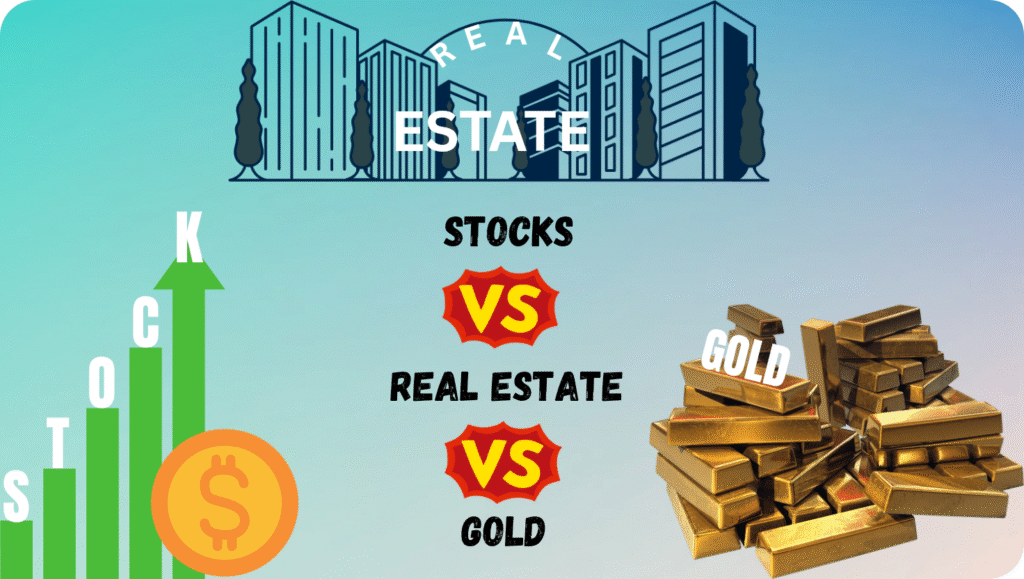Stock Market vs Real Estate vs Gold: Which is Better in India?

Choosing between the Indian stock market, real estate, and gold is a central question for investors seeking growth, income, or safety. Each asset class has distinct features, risks, and historical performance in the Indian context. This analysis compares these three options using Indian data, focusing on returns, risk, liquidity, income, taxation, and suitability for various investor profiles.
- Stock Market vs Real Estate vs Gold: Which is Better in India?
- Overview of Asset Classes in India
- Historical Returns: Indian Timeline Perspective
- Stock Market (Nifty 50 & Sensex)
- Real Estate (India)
- Gold (India)
- Timeline Map: Growth of ₹10 Lakh Over 20 Years (2005–2025)
- Key Features Compared (India)
- 1. Liquidity
- 2. Income Generation
- 3. Risk and Volatility
- 4. Inflation Hedge
- 5. Leverage
- 6. Taxation
- Simple Calculations: Return Scenarios (India)
- Example 1: 10-Year Investment (₹10 Lakh Initial Investment)
- Pros and Cons Table (India)
- Who Should Choose What?
- Expert Views and 2025 Outlook (India)
- Conclusion: Which Is Better in India?
- Summary Table: Quick Comparison (India)
Overview of Asset Classes in India
| Asset Class | Nature | Liquidity | Income Potential | Typical Use Case |
|---|---|---|---|---|
| Stock Market | Paper Asset | High | Dividends | Long-term growth, wealth |
| Real Estate | Physical Asset | Low–Medium | Rental Income | Wealth creation, income |
| Gold | Physical Asset | Very High | None | Capital preservation, hedge |
Historical Returns: Indian Timeline Perspective
Stock Market (Nifty 50 & Sensex)
- Long-term average annual return (Nifty 50, 2005–2025): ~12–14% (nominal), ~9–10% (inflation-adjusted).
- Volatility: High; Indian indices have seen sharp corrections (e.g., 2020 pandemic, 2025 crash).
- Growth Example: ₹10 lakh invested in Nifty 50 in 2005 would be worth over ₹96 lakh by 2025 (assuming ~13% CAGR and dividends reinvested).
Real Estate (India)
- Long-term average annual price appreciation (major cities): ~7–9% (excluding rental income and tax benefits; varies by city and cycle).
- Total returns (with leverage, rental income, and tax benefits): Can reach 12–15% annually in strong markets.
- Volatility: Lower than stocks; prices rise steadily but can stagnate or fall during downturns (e.g., post-2013 slowdown).
Gold (India)
- Long-term average annual return (2005–2025): ~10–11% (high volatility, no income component; strong performance during global crises).
- Recent performance: Gold hit record highs in 2024–2025, reflecting global uncertainty and rupee depreciation.
- Volatility: High, especially during crises and currency swings.
Timeline Map: Growth of ₹10 Lakh Over 20 Years (2005–2025)
| Year | Stocks (13% CAGR) | Real Estate (8% CAGR) | Gold (10% CAGR) |
|---|---|---|---|
| 2005 | ₹10,00,000 | ₹10,00,000 | ₹10,00,000 |
| 2010 | ₹18,57,000 | ₹14,69,000 | ₹16,10,000 |
| 2015 | ₹34,51,000 | ₹21,57,000 | ₹25,94,000 |
| 2020 | ₹64,10,000 | ₹31,70,000 | ₹41,82,000 |
| 2025 | ₹1,18,93,000 | ₹46,57,000 | ₹67,27,000 |
Assumptions: Compounded annually, no withdrawals, no taxes, gold at 10% CAGR, real estate at 8% CAGR, stocks at 13% CAGR (reflecting Indian market outperformance over the last two decades).
Key Features Compared (India)
1. Liquidity
- Stocks: Highly liquid; can be traded instantly during market hours.
- Real Estate: Illiquid; transactions can take months, with high stamp duty and registration costs.
- Gold: Extremely liquid; can be sold instantly in physical or digital form.
2. Income Generation
- Stocks: Dividends provide regular income (varies by company).
- Real Estate: Rental yields in India average 2–3% (residential) and 6–8% (commercial).
- Gold: No income; only capital appreciation.
3. Risk and Volatility
- Stocks: High volatility; sharp swings during events like the 2020 pandemic or 2025 crash.
- Real Estate: Lower volatility; prices are more stable but can stagnate or fall.
- Gold: High short-term volatility, but acts as a safe haven during crises.
4. Inflation Hedge
- Stocks: Generally outpace inflation over the long term.
- Real Estate: Good inflation hedge due to tangible value and rental income.
- Gold: Traditionally the best hedge against inflation and rupee depreciation.
5. Leverage
- Stocks: Margin trading possible, but risky.
- Real Estate: Leverage through home loans is common, amplifying returns (and risks).
- Gold: Leverage possible via gold loans, but less common.
6. Taxation
- Stocks: 10% long-term capital gains tax on equity (after 1 year, above ₹1 lakh); 15% short-term capital gains tax.
- Real Estate: 20% long-term capital gains tax (after 2 years, with indexation); rental income taxed as per slab.
- Gold: 20% long-term capital gains tax (after 3 years, with indexation).
Simple Calculations: Return Scenarios (India)
Example 1: 10-Year Investment (₹10 Lakh Initial Investment)
| Asset | CAGR | Value After 10 Years | Income Generated (Estimate) | Total Value |
|---|---|---|---|---|
| Stocks | 13% | ₹34,51,000 | ₹0 (excluding dividends) | ₹34,51,000 |
| Real Estate | 8% | ₹21,57,000 | ₹2,50,000 (rent @2.5%/yr) | ₹24,07,000 |
| Gold | 10% | ₹25,94,000 | ₹0 | ₹25,94,000 |
Assumptions: Rental yield at 2.5% of initial value per year, not compounded.
Pros and Cons Table (India)
| Asset | Pros | Cons |
|---|---|---|
| Stocks | High returns, liquidity, low entry cost | High volatility, market risk |
| Real Estate | Income, leverage, tax benefits, stability | Illiquid, high entry cost, management |
| Gold | Liquidity, safe haven, inflation hedge | No income, volatile, storage cost |
Who Should Choose What?
- Stocks: Best for long-term growth, those with higher risk tolerance, and investors seeking liquidity and compounding.
- Real Estate: Suitable for long-term wealth builders, those seeking passive income, and investors comfortable with illiquidity and property management.
- Gold: Ideal for capital preservation, hedging against uncertainty, and those needing liquidity or short-term safety.
Expert Views and 2025 Outlook (India)
- Stocks have delivered the highest long-term returns in India, but with significant volatility (e.g., 2025 crash, 2020 pandemic).
- Real Estate offers steady appreciation, income, and leverage potential, especially in high-demand urban markets, but returns have moderated since 2013.
- Gold has surged during periods of rupee weakness and global uncertainty, proving its value as a hedge, but lacks income and can be volatile.
- Diversification is widely recommended: A balanced portfolio with 10–15% in gold and real estate can help manage risk and reward.
Conclusion: Which Is Better in India?
There is no single “best” investment—each asset class serves different purposes:
- For maximum long-term growth: Indian stocks have outperformed both real estate and gold over the past 20 years.
- For steady income and stability: Real estate is superior, especially with rental yields and leverage.
- For capital preservation and crisis periods: Gold excels as a liquid, safe-haven asset.
A diversified approach—combining stocks, real estate, and gold—offers the best balance of growth, income, and safety. Your ideal allocation depends on your goals, risk tolerance, and investment horizon.
Summary Table: Quick Comparison (India)
| Feature | Stocks | Real Estate | Gold |
|---|---|---|---|
| Average Return | 12–14% | 7–10%* | 10–11% |
| Liquidity | Very High | Low–Medium | Very High |
| Risk | High | Medium | Medium–High |
| Income | Dividends | Rental Yield | None |
| Entry Cost | Low | High | Low |
| Inflation Hedge | Good | Good | Excellent |
| Tax Benefits | Moderate | High | Low |
*Including rental income and leverage.
Final Thought:
In India, stocks, real estate, and gold each have a role in a robust investment strategy. The right mix depends on your personal circumstances, but history shows that Indian stocks offer the best long-term growth, real estate provides stability and income, and gold shines brightest during uncertainty. A diversified portfolio is often the wisest choice for most Indian investors.




